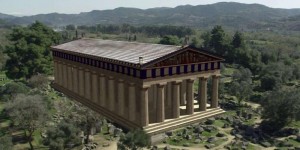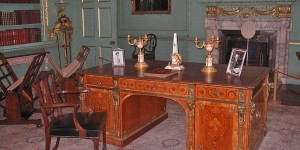From the previously discussed ethnographic studies of the Berber and Balinese households it is clear that many 'traditional societies' perceive the world in a different way to the way we do. These perceptions can be based on a number of ideas, for example, gender or the geography of place. Through these studies we can see how these may impact and help create the spatial orders within the societies. This is but a small selection which cannot wholly explain the diverse nature of how other communities perceive the world and in turn order their space. How the ideas and concepts identified in these ethnographic observations have been applied will be explored through the studies of:
- Mike Parker Pearson's "Food, Fertility And Front Doors In The First Millennium BC" (1996)
- Colin Richards' "Monuments As Landscape: Creating The Centre Of The World In late Neolithic Orkney (1996a)
Aspects of Joanna Brucks "Body Metaphors And Technologies Of Transformation In the English Middle And Late Bronze Age" (2001) will in addition be considered. How ethnographic studies and their subsequent employment, often as analogies, have impacted on interpretations of cosmology in European prehistory will be summarised towards the end.## Cosmology and ethnography in archaeologyFor Richards, his study of the Balinese household led to a re-appraisal of houses on Orkney (Richards 1996: 171b) particularly in regard to how cosmological principles come to be embodied in architecture. In turn the architecture comes to act as microcosm and metaphor for the world as a whole. These ideas are at the centre of Architecture and order: Approaches to social space by Pearson and Richards (1994), which aimed to illustrate how architecture "embodies and expresses certain principles of order and classification" (Pearson and Richards 1994: 38). Ethnographic studies of cosmology are most commonly employed in an analogous way such as in the case of Richards's studies in the Orkneys. Richards' reappraisal of structures such as those at Skara Brae and Barnhouse draws upon ideas of a communal attitude to the cosmological ordering of space. At Barnhouse one structure came to be identified as a communal meeting space centred on a hearth, which acts as the axis mundi1 for those present. Boivin (2000) employs a similar idea of using ethnographic ideas as a way of explaining certain practices, in this case the re-flooring of homes in Catalhoyuk. Boivin makes the analogy between this practice and the Indian practice of re-plastering floors based on seasonal patterns (ibid: 367). The issue of analogy will be touched upon later.
Pearson's study provides an "exploratory investigation into the potential for reconstructing symbolic systems in Southern Britain during the first millennium BC" (Pearson 1996:128). As with Richards, Pearson focuses on the structures and applies concepts derived from ethnographic studies in an effort to understand cosmology in round houses; in particular the idea of orientation and divisions within. Hard data from investigation is coupled with an awareness of ethnographic examples in order to explain the trends seen. As outlined in his introduction, Pearson draws upon a number of studies, not just the one, as is the case with Richards. Pearson takes broad ethnographic ideas and concepts that exist out of our way of thinking and applies them onto the Iron Age roundhouses. Applications of such data raise questions around how an awareness of ethnographic examples should be deployed when looking at prehistory. The idea of space and time being focussed and embodied in particular objects is an idea utilised by Joanna Bruck (2001) when she looks at quern stones in the Bronze Age. Bruck interprets the quern stone as acting as the central metaphor like the loom in the Berber household. These studies are but a small sample of those that have either employed ethnographic examples directly or indirectly. Other examples include the application of Madagascan views of material metaphors and their application to the ritual landscape of Stonehenge by Pearson and Ramilisonna (Pryor 2004: 230). In particular the idea of stone representing death and wood for the living (ibid: 321). The issues and ideas raised by ethnographic studies are considered in light of the evidence as a way of approaching a more holistic understanding of European prehistory.## Conclusion Fundamental to the application of ethnography in particular to cosmology is understanding how we employ analogy. Whilst ethnographic studies can impact positively on archaeology they can also impact negatively by being employed in an uncritical manner (Wobst 1978: 303). It is worth considering the way in which analogies are made. An analogy is, at its most basic concept, the comparison of two things that seem similar and thus provide the basis for inference. This inference can be made either directly or indirectly. The indirect form being to try and build a set of ideas you can apply to any context, as in the case of Pearson roundhouse study (1996). In the majority of cases ethnography is often used indirectly and as such is rarely cited directly. By employing analogy indirectly one avoids stating outright that one is the same as the other, rather it is employed more subtly to provide frameworks for understanding.
What the ethnographic studies of the Berber and Balinese households do is to highlight a number of ideas and concepts that should perhaps be considered when interpreting ancient European cosmology. These ideas include the relationship of people and ideas to architecture, the way in which all things - including the arrangement of domestic space - can come to embody cosmological ideas. That this relationship can in some cases, as in the Berber household, be quite complicated and, as such, any material remains would do little to illustrate the issues.
The fundamental point being that metaphors are an ever present factor in societies and can be played out in a number of forms, most of which are now unrecoverable to the archaeologist. Hence Richards perception of the prehistoric past as an "alien entity" (Richards 1996:171b) where it is not a paucity of evidence (Thomas 1991:2), but rather defining what evidence is significant and the interpretive frameworks employed that is the issue. Ethnography no doubt is one such investigative tool that forms a component in making interpretations. It cannot be used on its own to provide direct answers, but does serve to highlight the difficulties and issues in interpreting the data due to the complexities of belief structures. Archaeology is a subject area that requires a multi-faceted approach if we wish to understand the past fully, of which ethnography is merely one facet.## Notes 1: Axis mundi: The central point of any cosmological system essentially means the centre of the world. Provides a focal point and also a reference point for members of the community. An axis mundi can exist within the larger landscape and in the domestic setting.## Bibliography
- Boivin, N. (2000) 'Life rhythms and floor sequences: excavating time in rural Rajasthan and Neolithic Catalhoyuk', World Archaeology 31: 367-388.
- Brück, J. (2001) 'Body metaphors and technologies of transformation in the English Middle and Late Bronze Age', in J Brück (ed.), Bronze Age Landscapes: Tradition and Transformation 149-60. Oxford: Oxbow.
- Parker Pearson, M. & Richards, C. (eds.)(1994) Architecture and order: approaches to social space. London: Routledge.
- Parker Pearson, M. (1996) 'Food, fertility and front doors: houses in the first millenium BC', in T. Champion & J. Collis (eds.), The Iron Age in Britain and Ireland: Recent Trends, 117-32. Sheffield: Sheffield University Press.
- Pryor, F. (2004) Britain BC. London: Harper Perennial.
- Richards, C. (1996a) 'Monuments as landscape: creating the centre of the world in late Neolithic Orkney', World Archaeology 28(2) 190-208.
- Richards, C. (1996b) 'Life is not that simple: architecture and cosmology in the Balinese house', in T Darvill & J Thomas (eds.), Neolithic Houses in Northwest Europe and Beyond, 173-84. Oxford: Oxbow.
- Thomas, J (1991) Rethinking the Neolithic. Cambridge: Cambridge University Press.
- Wobst, H.M (1978) 'The archaeo-ethnology of hunter-gatherers or the tyranny of the ethnographic record in archaeology', American Antiquity 43 (2): 303-309.






